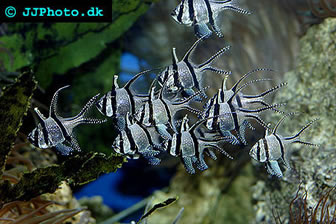Bangaii Cardinalfish
Pterapogon kauderni
Common name: Bangaii Cardinalfish
Scientific name: Sphaeramia nematoptera
Max size: 3 in / 7.5 cm
pH: 8.1-8.4
Salinity: 1.020-1.025
Temperature: 72-78ºF (22-26°C)
The Bangaii cardinalfish is a fairly new addition to the hobby. It has only been available in the trade since 1995 but has become a very popular fish. In the wild, this species has a very limited distribution and is becoming increasingly endangered due to collection for the aquarium trade, so you should by aquarium bred Bangaii cardinalfish whenever possible. This is also a good reason to try to breed your Bangaii cardinalfish. It is relatively easy and you can read more about it under the breeding header in this article. You can help the wild population of Bangaii cardinalfish by visiting this site.
The Bangaii cardinalfish is very suitable for beginners; it is hardy, friendly, readily available and cheap. It is even possible for marine beginners with freshwater experience to successfully breed the species. The Bangaii cardinalfish will tolerate less than ideal conditions but you should still strive to give them the best environment possible.
The Bangaii cardinalfish is suitable for community aquariums with other friendly species. You should never keep them with predatory fish or aggressive fish such as angels and triggers. The Bangaii cardinalfish is not 100% reef save as they will eat small ornamental shrimps and other small invertebrates, but they never bother coral, anemones and gorgonians.
The Bangaii cardinalfish originates from the Banggai Islands in Indonesia. It is not found anywhere else.
Bangaii Cardinalfish care and aquarium setup
Bangaii Cardinalfish is best kept in an aquarium that is no smaller than 30 gallon /120 L (a single specimen can be kept in a 20 gallon / 80 L tank). I recommend a larger aquarium if you want to keep a larger school of them.
The aquarium should be decorated with overhangs and caves, and the overhangs should be large enough for all your Bangaii cardinalfish to spend the days in the shade under them. The fishes will also appreciate sea grass to hide among. In the wild, this species is often found hiding among the spines of sea urchins and they love if you can mimic these sea urchin spines in the aquarium. This is however not necessary to keep them. You can use whatever bottom substrate you see fit. Corals and anemones can be included in the decoration.
The Bangaii Cardinalfish prefers a softer lit aquarium that is well circulated.
Ideal conditions for the Bangaii Cardinalfish is pH 8.1-8.4, salinity 1.020-1.025, and temperature 72-78ºF (22-26°C).
Feeding Bangaii Cardinalfish
Bangaii cardinalfish are very easy to feed as they accept flake food and just about any other food imaginable. It is important to give them a varied diet, especially if you want your Bangaii Cardinalfish to breed. A good diet can be based around high quality flake food but should also include frozen food such as vitamin enriched brine shrimp and fine chopped sea food. Feed 2-3 times a day.
Breeding Bangaii Cardinalfish
Sexing the Bangaii Cardinalfish based on outer appearance is hard but can be done. The males have a longer posterior dorsal fin than the females. Females have rounder bodies than the males.
The Bangaii cardinalfish is easy to breed in aquariums. They are mouth brooders and form breeding pairs where the male carries the eggs. If you want to breed Bangaii Cardinalfish you should provide them with a lot of food and a good varied diet. You should also try to keep the water quality as high as possible and the environment in the aquarium stress free. Once a Bangaii Cardinalfish pair have started breeding they will usually continue to spawn regularly.
The Bangaii cardinalfish is aggressive during the breeding period. The male chases other fish away from the female until he takes the eggs in his mouth. At this point the roles become reversed and the female starts to chase away fish that comes to close to the male. The male carries the eggs in his mouth for 3-4 weeks without eating. He can often be seen moving the eggs around in his mouth.
Bangaii cardinalfish fry are relatively large when they are released and can be fed newly hatched brine shrimp right from the start. The fry are aggressive towards each other and it can be good to separate them into different tanks to make sure that all fry get enough food; otherwise the stronger Bangaii cardinalfish fry will chase the weaker fry away from the food and prevent them from getting enough food. Bangaii cardinalfish fry grow fast and are easy to raise as long as you make sure they get enough food. If you don't separate them into different holding areas you can expect a mortality rate around 30-50% for the fry.
Cardinalfish Articles:
Pajama Cardinalfish – Sphaeramia nemotoptera
Anthias
Aquarium Chillers
Basses
Batfish
Blennies
Butterflyfish
Cardinalfish
Clown fish
Corals
Damselfish
Files
Goatfish
Gobies
Gorgonians
Grammas
Groupers
Grunts
Hawkfish
Jawfish
Jellyfish
Lionfish
Dragonets
Mantis shrimp
Marine angelfish
Marine Catfish
Moray eels
Nudibranch
Octopus
Pipefish
Protein skimmers
Pufferfish
Rabbitfish
Rays
Snappers
Scorpionfish
Sea Anemones
Sea horses
Sea Stars
Shark Fish
Shrimps
Snails
Squirellfish
Surgeonfish
Triggerfish
Wrasses

